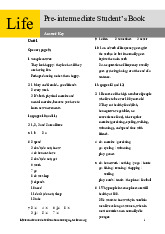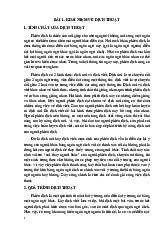



Preview text:
LESSON PLAN
TIẾNG ANH 11 FRIENDS GLOBAL UNIT 4: HOME
LESSON 4A - VOCABULARY: DESCRIBING HOUSES AND HOMES I. OBJECTIVES
By the end of this lesson, students will be able to: 1. Knowledge
- Understand and comprehend a conversation about homes, including discussions on
types of home, parts of a house and garden, and adjectives for describing houses and rooms.
- Acquire and retain vocabulary related to different types of homes, specific parts of a
house and garden, and descriptive adjectives. 2. Competences
- Demonstrate the ability to use and apply the newly acquired vocabulary accurately and
appropriately in conversations and written descriptions about homes.
- Describe and discuss different types of homes, specific features of houses and gardens,
and the appearance and characteristics of various rooms. 3. Personal qualities
- Show creativity in describing homes using appropriate adjectives.
- Cultivate an appreciation for different types of homes and architectural features. II. MATERIALS
- Grade 11 textbook, Unit 4, Vocabulary
- Computer connected to the Internet - Projector / TV - PowerPoint Unit 4A III. PROCEDURES
1. Activity 1: WARM-UP: (5 mins) a. Objectives:
- Introduce the new lesson and set the scene for Ss to acquire new language.
- Get students' attention at the beginning of the class.
- Activate students’ background knowledge. b. Content: - Word Relay. c. Products:
- Students contribute as a class. d. Procedure
TEACHER’S AND STUDENTS’ ACTIVITIES CONTENT Word Relay (5 mins)
- T explains the rules of the game: Each student will take turns house - ???
coming up with a word that starts with the last letter of the previous word.
- T set a time limit of 5 minutes
- The student who cannot come up with a word gets a minus point.
Then a new round begins with a new word. e. Assessment
- Teacher observes the groups and give feedback.
2. ACTIVITY 2: PRESENTATION (8 mins) a. Objectives:
- Students learn the form, pronunciation and when to use vocabulary related to the topic. b. Content: - Exercises 1, 2, and 3. c. Products:
- Ss discuss with their friends, do exercises in the book and say aloud the new vocabulary items. d. Organisation
TEACHER’S AND STUDENTS’ ACTIVITIES CONTENTS
Exercise 1: Look at the photos. What types of homes are they? Listen and choose from the words below. What type
of home do you live in? (3 mins)
- T goes through the words and check the meaning and A. mansion Pronunciation. B. thatched cottage
- T focuses attention on the photos. In pairs, students describe C. terraced house
them using words from exercise 1. D. flat
- T asks a few students to share their ideas with the class.
bungalow /ˈbʌŋɡələʊ/ (a house that is al on one level, without stairs)
thatched /θætʃt/ (having a roof made of straw),
detached /dɪˈtætʃt/ (not joined to any other house)
terraced /ˈterəst/ (forming part of a line of similar
houses that are all joined together)
Exercise 2: Work in pairs. Listen to the words below. Put them into two groups: those that are more likely to be a)
parts of a house and b) in a garden. (3 mins)
- In pairs, students check the meaning of any unknown words in
a. attic, balcony, basement, cellar, conservatory,
their dictionaries. They then put them into the two groups.
extension, hall, landing, porch, shutters, sliding
- T plays the recording for students to check their answers. doors, stairs, garage.
- T plays the recording again, pausing after each word so that
b. drive, fence, flowerbed, gate, hedge, lawn, path, students can repeat. patio, pond, swimming pool.
Exercise 3: Which is the odd-one-out? Explain why. Sometimes more than one answer is possible. (2 mins)
- Working individual y, students find the odd one out in
1. attic: It is at the top of the house; the cellar and each group. basement are below the house.
- T checks answers as a class.
2. porch: The lawn and path are part of the garden.
3. detached house: It is not joined to another house.
4. gate: It is not a border; it’s an entrance and it
opens. / hedge: It is made of plants.
5. villa: It is not moveable. / houseboat: It is on the water. e. Assessment
- Teacher observes Ss’ writing of vocabulary on their notebooks.
- Teacher checks students’ pronunciation and gives feedback.
3. ACTIVITY 3: PRACTICE (20 mins) a. Objectives:
- Students get exposed to new words in the context provided through spoken English. b. Content:
- Exercises 4, 5, 6 and 7. c. Products:
- Ss discuss with their friends, do exercises in the book and conduct oral correction. d. Organisation
TEACHER’S AND STUDENTS’ ACTIVITIES CONTENTS
Exercise 3: Listen to an estate agent showing someone round a house. Which seven parts of the house are mentioned in the dialogue? (5 mins)
- T elicits the meaning of estate agent (a person whose job is Answer key:
to buy and sell houses and land for other people) and ask:
front gate, hall, living room, kitchen, back garden, (back)
Has an estate agent ever shown you around a house? What fence, main bedroom.
character traits does an estate agent have? Elicit some
(The woman does not sound enthusiastic about the answers.
house, and it seems unlikely that she will buy it.)
- T goes through the instructions.
- T plays recording 2.04 for students to note the parts of a house mentioned.
- T checks the answers as a class. Then ask: What is the
woman’s overall impression of the house? Is she likely to buy it? Elicit ideas.
Exercise 5: Vocabulary Check. (5 mins)
- Ss match nine of the words with their meanings. There are
two words with the same meaning.
- They then check the meaning of the other words in their dictionaries.
- T checks the answers as a class.
Exercise 6: Listen again. Complete the sentences with words or phrases from the list in exercise 5. (5 mins)
- T goes through the instructions.
- T play the recordings for students to complete the sentences.
- With a weaker class, T plays the recording again.
- T checks answers as a class.
Exercise 7. Listen to four people describing their homes. Match sentences a–e with speakers 1–4. There is one extra sentence. (5 mins)
- T goes through the instructions.
- T plays recording 2.05 for students to match four of the sentences with the speakers.
- T checks the answers as a class. e. Assessment
- Teacher observation on Ss’ performance.
- Teacher’s feedback and peers’ feedback.
4. ACTIVITY 4: PRODUCTION (10 mins) a. Objectives: - Describe homes. b. Content: - Exercise 8. c. Products:
- Students give a short talk. d. Organisation
TEACHER’S AND STUDENTS’ ACTIVITIES CONTENTS
Exercise 8. Work in pairs. Describe your home to your partner. Use the phrases below to help you. (10 mins)
- Ss take turns to describe their homes to their partner using the
phrases. They should try to include as many of the words in
exercises 1, 2 and 5 as they can.
- After each description, the partner listening should visualize the
home based on the description and try to guess the type of home being described.
- T circulates and monitors, helping with vocabulary or grammar where necessary.
- T awards points for correct guesses and has the rest of the class
vote on the most imaginative description. e. Assessment
- Teacher observation on Ss’ performance.
- Teacher’s feedback and peers’ feedback. 5. CONSOLIDATION (2 mins) a. Wrap-up
- If T is using the Classroom Presentation Tool, first do the lesson closer to review what has been covered in this lesson.
- T asks students: What have you learned today? What can you do now? and elicits answers: I
can understand a conversation about a home. I can describe homes using vocabulary for types
of home, parts of a house and garden and adjectives for describing houses and rooms. b. Homework
- Prepare for the next lesson.




